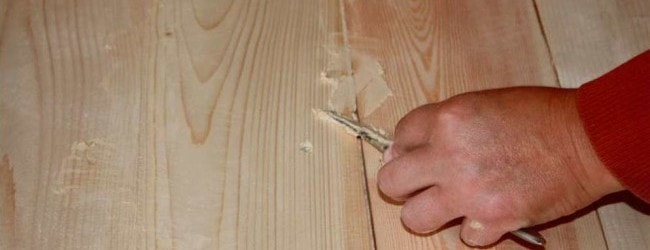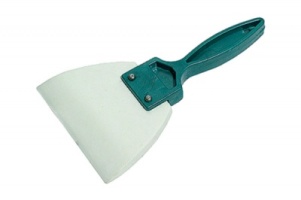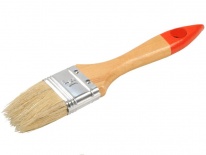The quality of work on insulation and glazing of a balcony directly depends on how carefully and accurately all the cracks and cracks are sealed. How to carry out this work and what materials to use depends on several factors:
- materials for the construction of the balcony wall;
- crack sizes;
- location of damage.
Let's look at the main points in more detail.
As a rule, for work to restore the integrity of balcony surfaces, the following are used: polyurethane foam, silicone, tile adhesive or cement concrete mixture. The use of each of these materials has its own characteristics.
Polyurethane foam is a universal material used for any surfaces and sizes of damage. The peculiarity of its use is the fact that the foam tends to expand, therefore it is better to fill the cracks with it not completely (by about 1⁄2). The dispenser tube on the polyurethane foam tube makes its use as convenient as possible. In this way you can blow out cracks in hard-to-reach places.
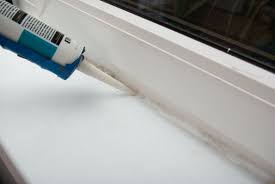
Silicone is also very easy to work with. It not only allows you to seal the gap, but also perfectly seals the surface, preparing it for further insulation and decoration.
Cement concrete mixture is a rather heavy material. It is used, as a rule, to seal cracks located in the lower part of the balcony (no higher than 20 cm from the floor).
As a lighter and more flexible material for sealing cracks and cracks, you can use tile adhesive.
How to seal cracks on a balcony made of plastic panels
The first thing you need to do is prepare necessary tool. You will need: sealant, spatula, solvent, mounting tape, scissors and a vacuum cleaner. Do not forget about means to protect your hands - rubber or thread gloves.
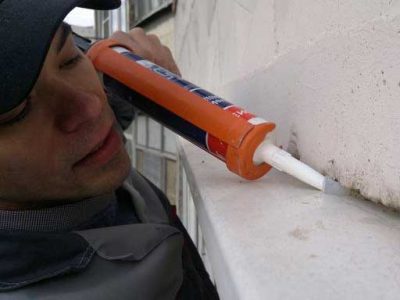
Then, adhering to a certain algorithm, we begin work on closing the gap:
- We carefully remove dirt, dust and debris, and also clean out crumbled cracks and chips with a spatula.
- Use a vacuum cleaner to remove any remaining dust that has accumulated in the crack.
- We treat damage to plastic with solvent or alcohol. Cracks or crevices prepared for further processing must be dry and free of grease. In order not to stain adjacent areas of the surface, the gap must be covered with mounting tape.
- Carefully seal the damage with silicone sealant and immediately remove excess sealant with a spatula. You must try to carry out the work carefully and as quickly as possible. Silicone sealant hardens very quickly and if you miss the moment, it will be impossible to fix the seam or remove excess.
How to repair damage on a concrete balcony
To quickly restore the integrity of the damaged surface, you need to prepare the following materials:
- primer;
- cement mixture;
- brush and spatula;
- mounting foam;
- solvent.
You will also need a broom or vacuum cleaner and gloves.
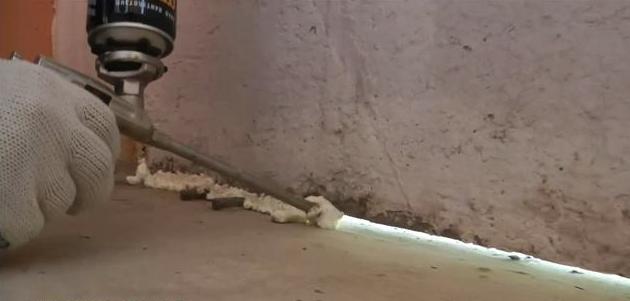
Before sealing the cracks on the balcony, they must be thoroughly cleaned, treated with a primer and blown out with foam. Considering the fact that polyurethane foam tends to expand, the crack is only half sealed. After the foam has dried, the excess must be cut off and the sealed surface covered with cement mortar.
How to seal cracks on a wooden balcony
For work you may need: wood putty, spatula, knife, sandpaper.
Procedure:
- Cracks in wood can be easily cleaned of dust. If necessary, rotten or insect-damaged areas are cut off.
- Cracks are sealed with a special wood putty. Excess must be removed immediately, without waiting for the putty to dry completely.
- The sealed surface is cleaned with sandpaper and, if necessary, covered with varnish or paint.
How to close small gaps on a balcony
In order to seal the gap in the joints between two surfaces, it is best to use silicone sealant. This easy-to-use material easily penetrates into any corner, thoroughly filling the damage.
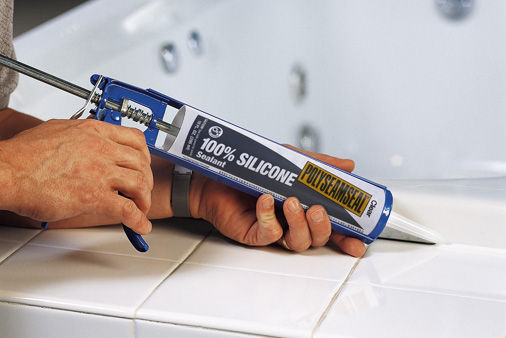
If cracks have appeared on the surface of the wall or, there are many of them and they are quite small, then the best sealing is to treat the damaged surface with plastic and light mixtures for laying tiles. For wood, you must use a special putty for wooden surfaces.
How to seal very large gaps on a balcony
If a crack of up to 8-10 cm in size appears on the balcony, it can be very easily repaired using polyurethane foam. But what to do if the size of the gap is such that a person’s palm fits into it. In this case, it is better to use foam together with galvanized iron. More often this method used if it is necessary to close a crack between the floor and.
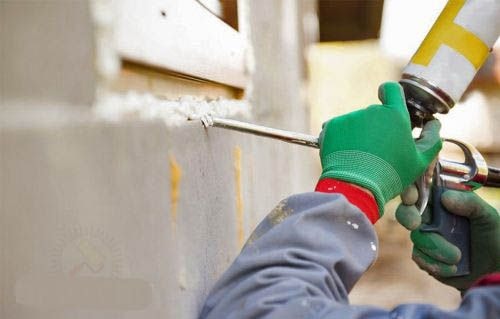
To work you will need:
- galvanized iron sheet;
- metal screws;
- metal scissors;
- tape measure, ruler;
- perforator;
- polyurethane foam;
- gloves and broom.
Algorithm of actions:
- We carefully measure the size of the crack.
- Using metal scissors, cut out the required piece from a galvanized sheet, adding 15 cm along the edges to form corners.
- Use a hammer to hammer the sheet into the required shape to seal the crack.
- Using fasteners, we securely fix the shield to the surface of the balcony.
- The remaining cracks and voids are filled polyurethane foam, the excess of which must be removed.
- Using lining, tiles or you can create an aesthetic and beautiful view sealed gap.
How to quickly seal a gap in a balcony ceiling
This is a rather unpleasant situation when, due to the fault of the builders, between the wall and the ceiling that forms the ceiling, there remains a fairly large gap through which water can flow. It is better when such a problem is solved together with the neighbors above, because the ceiling of your balcony is the floor of the balcony of the neighbors on the floor above.
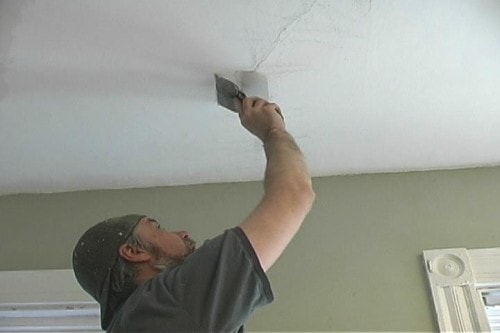
From your balcony you need to do the following:
- Thoroughly clean the dust and dirt from the crack. For more High Quality For work, you can use metal wire mesh.
- The cleaned gap is thoroughly coated with a primer and sealed with waterproofing mastic or polyurethane foam. Foam is a more convenient material to work with. After it dries, the excess is removed, and the cleaned area is covered with cement mortar.
It is necessary to repair cracks of any size (even very small ones) and on any surface of the balcony. This will help prevent serious damage and costly repairs in the future.
There is nothing eternal in the material world. From time to time something breaks and begins to deteriorate, for example, a balcony. No, it doesn't fall, but cracks and crevices appear. As a result, the problem arises - how and how to seal the cracks on the balcony and whether it needs to be done. Of course it is necessary. After all, by repairing defects, you improve the functional qualities and aesthetic appearance of the balcony.
It is necessary to seal cracks on the balcony and loggia to prevent heat loss and improve sound insulation.
Seal small cracks and crevices
Your balcony is made of plastic, concrete, wood... However, it is not so important what exactly it is made of, the main thing is that the gap is small and does not penetrate outside or to the neighbors. We seal such a gap with silicone sealant, polyurethane foam, cementitious mortar, and wood putty.
Important: polyurethane foam is suitable for working with any material, silicone sealant - with plastic and wood (and their derivatives), cementitious mortar - only for concrete.
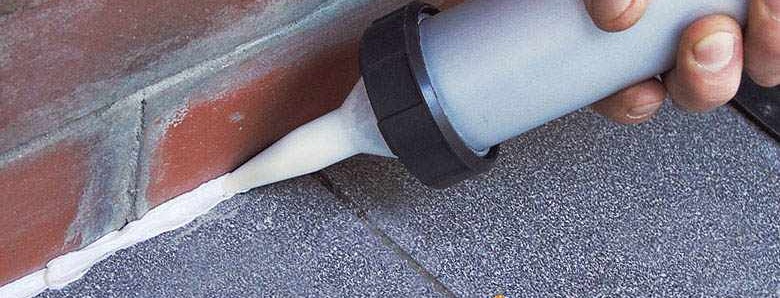 A small gap or crack on a balcony or loggia can be sealed with silicone sealant, polyurethane foam, cementitious mortar, or wood putty.
A small gap or crack on a balcony or loggia can be sealed with silicone sealant, polyurethane foam, cementitious mortar, or wood putty. If your balcony is plastic...
You will need:
| Silicone sealant  |
Applicator gun
|
||
|
|
|
Work order
We remove the dirt and sand the crumbling elements.
If there is a lot of dust in the crack, use a vacuum cleaner.
We treat the gap with a solvent (degrease), or you can treat it with alcohol. There should be no moisture, we work with a dry gap.
If you're worried about getting everything dirty, use mounting tape and stick it on both sides of the gap.
Immediately remove excess with a rubber spatula. After 20 minutes, you will no longer be able to give an aesthetic shape to the silicone seam. Try to do everything quickly. Please note that the freezing depth silicone sealant depends on the ambient temperature. The higher the temperature, the faster it hardens. At room temperature at 18-20 degrees, the glue hardens in about a day.
If your balcony is concrete...
You should have on hand:
|
|
|
|
We clean the crack as described above, according to points 1, 2, 3. Then we treat it with a primer and seal it with foam. The foam tends to expand, so we close the gap 2/3. After the foam has dried, remove the excess with a knife and apply a cementitious solution.
If you have a very small crack, then you can seal the cracks on the balcony in the concrete slab using only a cementitious mortar.
If the balcony is wooden...
The gap is small, but you don’t like the foam, and you don’t want to work with it. In this case, you can use wood putty. We traditionally clean the gap, then apply putty. Carefully remove excess and sand with sandpaper. Afterwards we varnish. The varnish can be matched to the tone of the wood, so as not to apply paint on the wood in the future.
Seal large gaps
If there is a formation on your balcony through hole or the size is such that a palm can fit there, then we will call such a hole a large gap. A gap up to 8 cm in size is filled with polyurethane foam. There is no need to wonder how to seal the cracks on the balcony. Foam is the best option. And it doesn’t matter what material your balcony is made of.
Necessary materials and tools:
| Applicator gun
|
or primer (for concrete and then and other) |
|
|
|
|
(for concrete) |
|
| Varnish (for wood)  |
Paint for plastic panels (Maybe) |
The procedure for sealing a gap on a balcony is similar to the previous ones:
- Thoroughly clean the gap of debris.
- Treat the edges with primer or solvent.
- Fill with foam.
- After the foam has hardened, remove excess.
- Treat the surface:
concrete - cement mortar;
wooden - primer, varnish;
plastic – special paint on plastic.
Seal very large gaps
To seal very large gaps on the balcony, it is better to use galvanized iron and polyurethane foam.
The sequence of actions will be as follows:
- We measure the size of the gap.
- Cutting with metal scissors right size, adding 15-20 centimeters to form a corner.
- We form the shield using a hammer.
- We attach the corner with dowels and screws.
- We foam small cracks.
- Cut off the excess foam.
- We give an aesthetic look using any decor ( plastic panels, lining, wood, tiles).
Important: canopies and ebbs should be installed on the balcony, allowing rainfall to drain from small external cracks and protecting the balcony from excess moisture.
With timely sealing of cracks and crevices on the balcony, you will make your balcony a safer and more comfortable room in your house or apartment.
Video: how to use polyurethane foam correctly
When, during an apartment renovation, the turn comes to a balcony or loggia, most people try to make a cozy corner for relaxation there, sometimes a convenient area for a workplace or household needs. Increasingly, balconies are being glazed and insulated. This solution not only improves the appearance of the facade and adds warmth to the apartment, but also gives its inhabitants a noticeable increase in living space. When glazing a balcony, cracks and small gaps often remain, since due to the unevenness of the slabs it is impossible to fit the material perfectly together without gaps.
How to seal cracks on balconies and loggias:
1. Eliminating cracks on concrete surfaces
Often there are gaps of several centimeters between the concrete floors. In such cases, polyurethane foam, cement mortar, and primer are used.
Firstly, the end of the gap must be thoroughly cleaned of dust and debris, and elements that are poorly attached or weakened under the influence of water or other factors must be removed.
After cleaning, you need to make sure that there is no moisture in the crack, then we treat the crack with a primer and fill the holes with foam.
It is better to use foam with a special gun (a device into which a bottle of foam is inserted), this will make it possible to deliver the foam to hard to reach places. Since the foam has the ability to expand, you don’t need to squeeze it out a lot. It is enough to pour in a little more than half the volume of the crack to seal it. Within a few hours, the foam will expand, filling all the small pores hermetically.

After a day, excess foam can be cut off with a stationery or ordinary knife and everything can be puttied with a thin cement mixture. Instead of cement mortar, you can use paint. The main thing is to close the foam from solar radiation which destroys it.
If there are small cracks in the concrete, they can only be sealed with cement mortar.
But sometimes the gaps between the plates are more than 8 cm. In this case, the polyurethane foam will not be enough. Galvanized iron is mainly used to cover such a space.
Strips are cut out of a sheet of iron using metal scissors, which are then bent into corners for the slabs. Such corners are fastened using a puncher to dowels. Depending on the size of the gaps, the corners can be attached to one of the plates or to two at once. After reducing the size of the crack, it is filled with polyurethane foam. Then the excess is cut off and primed or painted.
2. Eliminating cracks on wooden surfaces
If the gap is large enough, you can try filling it with foam. But, when working with foam and wood, you need to be very careful. Wood is a soft material and is easily deformed when force is applied, and using more foam than necessary can easily dislodge wooden elements. The consequence may be a window or door not closing.
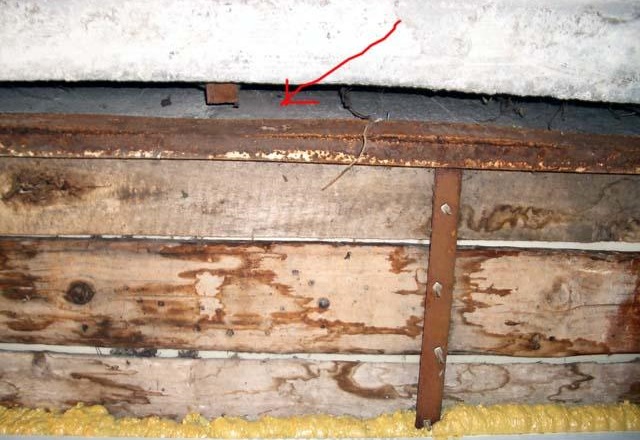
For wood, it is better to buy ready-made factory putty. Before starting work, the gap must also be cleaned of dust, dirt and crumbling rotten elements. It must be applied with a spatula and very carefully. After complete drying, the area with putty is thoroughly rubbed down. sandpaper and varnished or painted to match the wood.
3. Elimination of cracks on plastic surfaces
Silicone sealant is most suitable for working with cracks in plastic surfaces.
The use of cement mortar and foam is excluded (for the same reason as for wooden surfaces).
To seal holes in plastic, you will need the following materials: a package of sealant, a gun for a bottle of sealant, a spatula with a rubber tip, tape with a double-sided adhesive layer, hand gloves, and solvent.
Clean the surface of the crack and dry it thoroughly. Silicone tends to stick to everything, so you need to use it carefully and try not to stain anything. In order for the sealed gap to look neat, it must be covered with tape on both sides before applying silicone.
Fill the hole with silicone using a gun. It has a long tip and makes it possible to reach the most inconvenient places. We immediately remove excess sealant and any imperfections with a spatula with a rubber tip. It is better to remove excess sealant immediately, since after hardening it will not be possible to do everything neatly due to the silicone consistency.
After the sealant has hardened, we check to see if we missed anything. If there are areas with cracks left somewhere, then we do the work to eliminate the gaps. When everything is perfectly done, remove the tape.
The advantages of silicone are its transparency; after hardening, it does not require additional priming or painting.
You need to get rid of cracks not only from below, but also in the upper slabs that serve as the roof of the balcony or loggia. We use the method for concrete floors. You can replace the foam with waterproofing mastic. If there is a crack in the upper ceiling, then it is advisable for the neighbors above to also carry out procedures to eliminate it, otherwise moisture will still be able to penetrate your balcony.
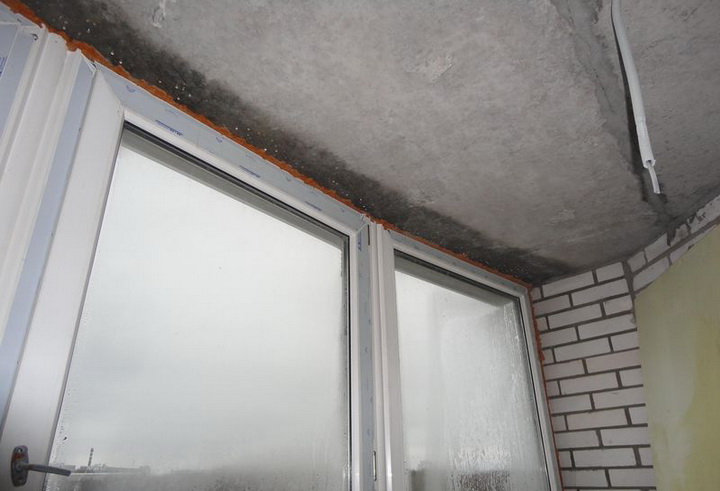
After the cracks have been eliminated, the balcony can be insulated or repaired. With the correct method of sealing cracks, the balcony will be protected from drafts, precipitation and cold.
From time to time, sealed cracks need to be checked to see if the material has peeled off and if unfinished gaps have appeared.

